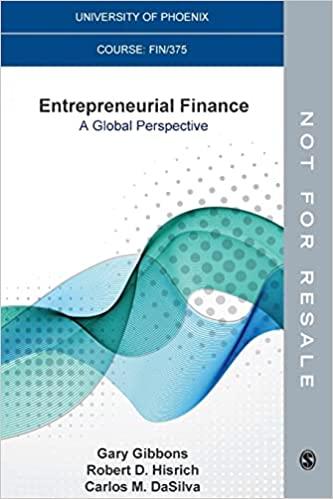Question
19) On January 1, 2020, Dave Coates, a 23-year-old mathematics teacher at Xavier High School, received a tax refund of $1,100. Because Dave didnt need
19) On January 1, 2020, Dave Coates, a 23-year-old mathematics teacher at Xavier High School, received a tax refund of $1,100. Because Dave didnt need this money for his current living expenses, he decided to make a long-term investment. After surveying a number of alternative investments, Dave isolated two that seemed most suitable to his needs.
Each of the investments costs $1,050 and pays income over 10 years. The first investment is a bond that promises 10 annual payments of $50 and an additional $1,000 payment at the end of the 10th year. Dave thinks that the income stream promised by the bond is relatively safe, and based on the returns offered by other safe investments, Dave believes that 4% is an appropriate discount rate for the bond. The other investment is a small ownership stake in a local business. According to the owner of this business, in return for his $1,050 investment, Dave would receive a series of cash payments that would rise and fall over the next 10 years (as shown in the table). Dave judges that investing in this business is riskier than buying a bond, so he thinks that he would need to earn a 4% risk premium relative to the return he requires on the bond. Because neither investment fully exhausts his refund check, Dave plans to invest the extra $50 he has on hand in a bank account paying 3% interest compounded annually.
As he makes his investment decision, Dave has asked for your help in answering the questions that follow the expected return data for these investments.
|
| Expected Payments | |
| End of Year | Bond | Business |
| 2020 | $ 50 | $0 |
| 2021 | $ 50 | $150 |
| 2022 | $ 50 | $150 |
| 2023 | $ 50 | $150 |
| 2024 | $ 50 | $200 |
| 2025 | $ 50 | $250 |
| 2026 | $ 50 | $200 |
| 2027 | $ 50 | $150 |
| 2028 | $ 50 | $100 |
| 2029 | $1,050 | $50 |
Questions
- Assuming that the two investments are equally risky and using a 4% discount rate, calculate the present value of each investments cash flows and explain to Dave what your analysis implies about which investment he should choose.
- Recognizing that buying a stake in a business is more risky than purchasing a bond, reassess the two alternatives, adding the 4% risk premium to the discount rate for the bond to arrive at a discount rate for the business investment. Does your advice for Dave change relative to question a?
- From your findings in questions a and b, indicate whether the IRR for the bond is above or below 4% and whether that for the business investment is above or below 8%. Explain.
- Calculate the IRR on each investment and comment on what you find in light of your answer to part c.
- Explain which investment Dave should make or if he should make neither of them.
- How much will Daves $50 investment in the saving account grow to by 2029?
Step by Step Solution
There are 3 Steps involved in it
Step: 1

Get Instant Access to Expert-Tailored Solutions
See step-by-step solutions with expert insights and AI powered tools for academic success
Step: 2

Step: 3

Ace Your Homework with AI
Get the answers you need in no time with our AI-driven, step-by-step assistance
Get Started


